10 Best Welding Helmets in the UK in 2025: Reviews & Top Picks
Last Updated on
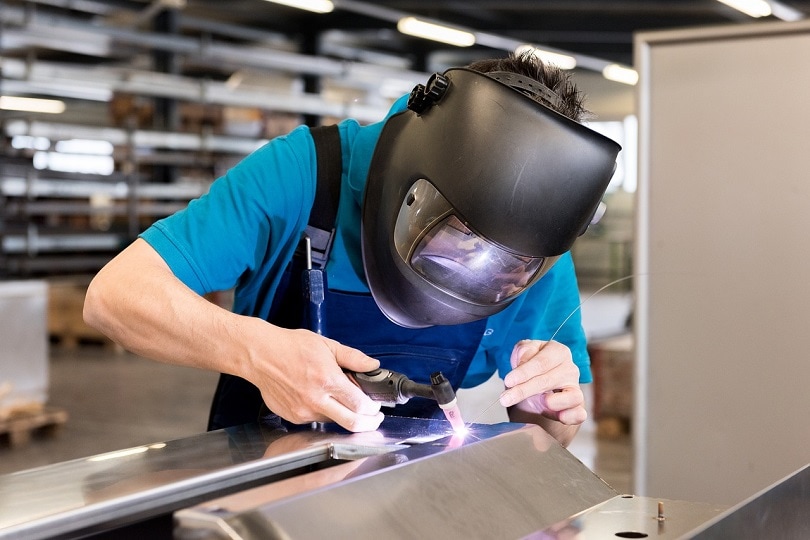
Welding is a potentially dangerous endeavor. Extreme temperatures, potentially dangerous levels of UV radiation, and the long-term negative effects of UV and welding fume are just some of the risks. High levels of visible and infrared light can also potentially damage your eyes.
A welding helmet is an essential piece of welding equipment. It protects the head, eyes, and neck from hot sparks, flash burns, ultraviolet, infrared, and heat. There are several features to look for to ensure you choose a welding helmet that offers safety and protection and is also suitable for the task at hand.
Below, you can find reviews of the 10 best welding helmets in the UK, as well as a guide on common features that you should be looking for when buying this important piece of safety gear.
A Quick Comparison of Our Favourites (Updated in 2025)
| Image | Product | Details | ||
|---|---|---|---|---|
| Best Overall |
 |
ESAB Sentinel A50 Welding Helmet |
|
CHECK PRICE |
| Best Value |
 |
Antra AH6-260-0000 Solar Power Welding Helmet |
|
CHECK PRICE |
| Premium Choice |
 |
Miller 281003 Digital Elite Welding Helmet |
|
CHECK PRICE |
 |
Hobart 770874 Inventor Series |
|
CHECK PRICE | |
 |
3M Speedglas Welding Helmet 100 |
|
CHECK PRICE |
The 10 Best Welding Helmets in the UK
1. ESAB Sentinel A50 Welding Helmet – Best Overall
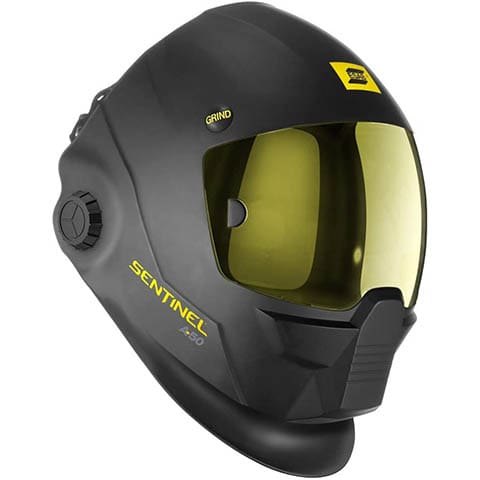
| Viewing Area: | 100 millimetres x 60 millimetres |
| Auto Darkening?: | Yes |
| Shade Range: | 5-8, 9-13 |
| Arc Sensors: | 4 |
| Lens Reaction Time: | 1/25,000 second |
| Weight: | 635 grams |
Auto-darkening helmets work by sensing light from the welding arc. A liquid crystal filter is activated when the light reaches a certain limit, which darkens the lens to a safe limit, protecting the wearer’s eyes from ultraviolet and infrared light. More arc sensors mean better coverage, which improves safety. The ESAB Sentinel A50 Welding Helmet uses four sensors, which puts it in the realm of a professional welding helmet. It also has a 100mm x 60mm viewing area, and its color touchscreen panel is easy to control with eight memory settings.
Overall, the Sentinel is a high-quality professional-grade welding helmet despite being very reasonably priced and is our choice as the best welding helmet in the UK. It offers good protection and controls. Its spherical lens means sparks bounce off more easily, and the design improves light transmission and durability. However, the lenses are more expensive to replace than standard ones, and they suffer from more glare. The helmet is also relatively small, which means it won’t be suitable for larger heads.
- Four arc sensors handy for out-of-position welding
- Excellent light transmission from spherical lens
- Reasonable price for a professional welding helmet
- Eight memory settings from the digital control
- Replacement lenses are expensive
- Tight fit for large heads
2. Antra AH6-260-0000 Solar Power Auto Darkening Welding Helmet – Best Value
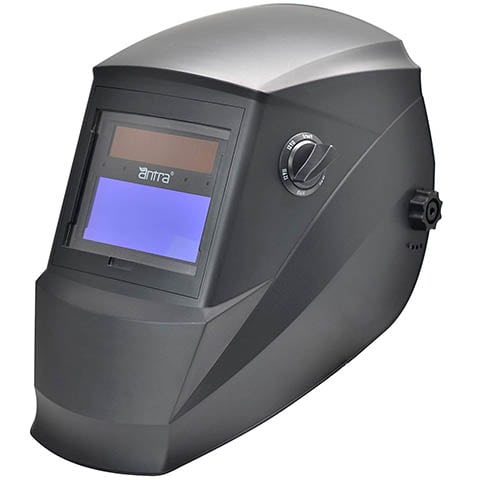
| Viewing Area: | 98 millimetres x 44 millimetres |
| Auto Darkening?: | Yes |
| Shade Range: | 5-9, 9-13 |
| Arc Sensors: | 4 |
| Lens Reaction Time: | 1/25,000 second |
| Weight: | 454 grams |
A welding helmet is your first and most important line of defense when welding. As such, experts recommend buying the best you can afford, but if you have minimal use of a helmet, you can find inexpensive, good-quality helmets that offer decent protection.
The Antra AH6-260-0000 Solar Power Auto Darkening Welding Helmet is a low-cost welding helmet with four sensors that offers shade ranges suitable for plasma cutting (5-9) and arc welding (9-13). Its reaction time is similar to most other helmets, and for the price, it is the best welding helmet in the UK for the money.
However, it is only designed for occasional or hobbyist use. It’s a plastic helmet that keeps the weight down and produces a lightweight design, but it feels flimsy and suffers some damage from heavy knocks. It is also tricky to get the fit and shade settings just right, and the viewing area is narrower and shorter than other helmets, which means moving your head around a lot more than with other helmets.
- Cheap
- Four arc sensors
- Solar-powered rechargeable batteries mean no need for replacements
- Lightweight design
- Plastic design is flimsy
- Tricky to get the settings right
- Viewing area could be more generous
3. Miller 281003 Digital Elite Welding Helmet with ClearLight Lens – Premium Choice

| Viewing Area: | 595 millimetres x 595 millimetres |
| Auto Darkening?: | Yes |
| Shade Range: | 5-8, 8-13 |
| Arc Sensors: | 4 |
| Lens Reaction Time: | 1/20,000 seconds |
| Weight: | 510 grams |
The Miller 281003 Digital Elite Welding Helmet with ClearLight Lens is part of the 281000 range that includes Miller’s ClearLight Lens technology. The lens improves contrast and clarity when welding and between welds, which makes it practical to leave the lens down when you’re not working. It has four settings, including X-Mode, which automatically blocks out sunlight.
The headgear is cushioned, which is designed to provide greater comfort for the user, although it can make it difficult to get the fit just right. Digital controls allow the adjustment of shade, delay, and overall sensitivity. The Digital Elite has a small viewing area. Still, it is an excellent all-rounder that can be used for indoor and outdoor welding without the fear of flashing, and the smaller viewing area compared to other Miller Digital models does keep the price down a little. It is also known for its rugged design, which means you don’t have to be gentle with the helmet; you shouldn’t easily cause damage or breakage.
However, while it isn’t the heaviest on the market, its design does mean that it isn’t a lightweight helmet, and the headgear is tricky to adjust and needs replacing quite soon. It also falls on the expensive side of the welding helmet price spectrum. The helmet comes in a good variety of designs and uses replaceable batteries.
- Rugged design is difficult to damage
- X-Mode is good for outdoor use
- Digital controls are easy to use
- Improved contrast and clarity
- Expensive
- Headgear won’t last as long as the helmet
4. Hobart 770874 Inventor Series
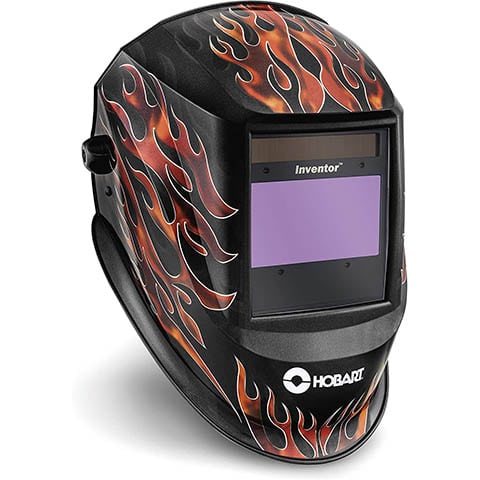
| Viewing Area: | 100 millimetres x 60 millimetres |
| Auto Darkening?: | Yes |
| Shade Range: | 9-13 |
| Arc Sensors: | 4 |
| Lens Reaction Time: | 1/25,000 second |
| Weight: | 558 grams |
The Hobart 770874 Inventor helmet is designed for serious hobbyist users. It is reasonably priced, although there are cheaper hobbyist helmets. It isn’t rated for plasma cutting but has 9-13 shades, meaning it can be used for welding and grinding. It also lacks true color technology, and the headgear is basic.
However, the viewing area is generous, and the lens does offer decent visual quality. And, while the headgear is a standard design, it’s also comfortable. The plastic shell is rugged enough that it won’t be easily damaged. It’s a surprisingly tough design for a helmet at this price point. Hobart is also a trusted name, and they offer excellent warranties that make this an appealing purchase for the hobbyist welder.
- Decent price for a quality brand
- Good viewing area size
- Comfortable to wear
- Hobart is a respected name
- Not rated for plasma cutting
- No colour technology
5. 3M Speedglas Welding Helmet 100

| Viewing Area: | 83 millimetres x 44 millimetres |
| Auto Darkening?: | Yes |
| Shade Range: | 8-12 |
| Arc Sensors: | 2 |
| Lens Reaction Time: | 1/10,000 seconds |
| Weight: | 456 grams |
The 3M Speedglas Welding Helmet 100 is another welding helmet that isn’t rated for plasma cutting but is suitable for hobbyists looking for a good-quality helmet from a well-known brand. The viewing area is smaller than most other helmets, but it is a lightweight unit made from aluminium and has a function that enables the user to delay dark-to-light time. The head suspension can be adjusted, and there’s a frame to hold and support magnification lenses without having to try and fix them yourself.
The helmet is reasonably priced, and because its aluminium frame is light, it’s easy to use, especially thanks to the digital controls. The lightweight design is also good for comfort on the head, which is further facilitated by adjustable, cushioned straps.
- Aluminum helmet is light but durable
- Adjustable head suspension
- Decent price
- Small viewing area
- 1/10,000 second reaction time is slower than a lot
6. Lincoln Electric Viking 3350 Welding Helmet

| Viewing Area: | 95 millimetres x 85 millimetres |
| Auto Darkening?: | Yes |
| Shade Range: | 6-9, 8-13 |
| Arc Sensors: | 4 |
| Lens Reaction Time: | 1/25,000 second |
| Weight: | 1,360 grams |
The Lincoln Electric Viking 3350 Welding Helmet is a professional welding helmet at a reasonable price. It has a huge viewing area, the largest in the Viking line, and a 1/25,000-second reaction time. That switching speed helps prevent eye fatigue and headaches so that you can carry on working for longer without having to give your eyes too frequent a break.
It is a very heavy helmet, unlike most others, although it has a good pivot design that spreads the weight across your head well. For some users, though, it will still prove too cumbersome for ongoing use. 4C lens technology provides good clarity, and the Electric Viking 3350 offers shade control from 5-13, which makes it suitable for plasma cutting, welding, and grinding. The Viking uses solar cell batteries, which are especially beneficial for those that use the helmet outdoors in sunny conditions, and the CR-2450 cells are easy to find.
Although a quality welding helmet, the Viking 3350 does not have waterproof electronics, so it shouldn’t be used outdoors in wet conditions, and some people will find it too heavy for regular use.
- Generous viewing area
- C4 lens technology makes sharpens colour
- Good adjustable headgear
- Heavy
- Can’t be used in wet conditions
7. YESWELDER True Colour Welding Mask Helmet

| Viewing Area: | 100 millimetres x 90 millimetres |
| Auto Darkening?: | Yes |
| Shade Range: | 5-9, 9-13 |
| Arc Sensors: | 4 |
| Lens Reaction Time: | 1/10,000 second |
| Weight: | 635 grams |
The YESWELDER True Colour Welding Mask Helmet is a hobbyist welding helmet that is inexpensive and has a large viewing area. It also has a shade range of 5-13, 4 sensors, and a lens reaction time of 1/10,000 seconds. Although the reaction time could be better, 10,000th of a second should be enough to prevent eye fatigue for casual and heavy hobbyist users. The large viewing area means the helmet is helpful for a good range of activities, and the shade range means it can be used for welding, grinding, and cutting. The headgear is adjustable, which, combined with the relatively lightweight feel of the helmet, makes it comfortable to wear.
However, the helmet is somewhat flimsy, and the adjustment controls are loose, so you will need to check the setting every time you start to weld.
- Cheap
- Good viewing field
- Comfortable headgear
- Flimsy
- Adjustment controls need checking every time
8. Optrel Panoramaxx CLT 1010.201

| Viewing Area: | 180 millimetres x 120 millimetres equivalent |
| Auto Darkening?: | Yes |
| Shade Range: | 4-13 |
| Arc Sensors: | 5 |
| Lens Reaction Time: | 1/10,000 second |
| Weight: | 600 grams |
The Optrel Panoramaxx CLT 1010.201 is a professional welding helmet with five arc sensors to help significantly reduce the chance of flare. It has a unique nose cut out that dramatically increases the field of view, such that a traditional welding helmet would need a 180 x 120-millimetre viewing angle to offer the same panoramic field of view. It uses Crystal Lens Technology to clarify the view and ensure that it isn’t distorted. It also has IsoFit headgear that aims to provide total comfort and security for the wearer. The helmet includes solar-recharged cells that can also be charged via USB, so you can always be sure that it is fully charged.
However, compared to more traditional helmets, the design is restrictive, almost like a full motorcycle helmet, and it is expensive.
- Equivalent to a 180 x 120-millimetre field of view
- IsoFix headgear attaches neatly to the head
- Five sensors ensure full coverage
- Expensive
- Restrictive shape
9. Dekopro Solar Powered Welding Helmet

| Viewing Area: | 98 millimetres x 80 millimetres |
| Auto Darkening?: | Yes |
| Shade Range: | 5-8, 9-13 |
| Arc Sensors: | 4 |
| Lens Reaction Time: | 1/25,000 second |
| Weight: | 454 grams |
The Dekopro Solar Powered Welding Helmet has a decent viewing area of 98 millimetres x 80 millimetres, and it is a lightweight mask with adjustable headgear to ensure that it fits snugly and comfortably. It is a hobbyist helmet with a low-price tag to match. The solar regenerating batteries also prolong the battery life and are especially useful for those that weld outdoors in sunny conditions.
However, while it is affordably priced, the Dekopro’s visor is loose, which means it tends to flop down, and the inside of the mask gets steamed up quickly, which will often happen in a welding environment. Also, the lightweight design means that the mask feels flimsy and doesn’t give much confidence to the user.
- Cheap
- Adjustable headgear
- Flimsy
- Visor is too loose
- Inside of the mask gets steamed up easily
10. True Colour Welding Mask

| Viewing Area: | 100 millimetres x 56 millimetres |
| Auto Darkening?: | Yes |
| Shade Range: | 5-9, 9-13 |
| Arc Sensors: | 4 |
| Lens Reaction Time: | 1/25,000 second |
| Weight: | 454 grams |
The True Colour Welding Mask is the cheapest welding mask on the list. It offers a 5-9 and 9-13 shade range, making it suitable for cutting, welding, and grinding, and it has a reasonable-sized viewer. It is lightweight, and the headgear is adjustable. You even receive five lens covers, which is surprising considering the meager price of the package.
However, the lightweight design feels flimsy and easily damaged. The padded headband’s adjustment options are limited, and the hard plastic is uncomfortable. Also, despite being a true colour welding mask, the visibility is somewhat poor, and the solar rechargeable batteries need charging often.
- Really cheap
- Five lens covers included
- Decent viewing angle
- Flimsy
- Solar rechargeable batteries are poor and need frequent recharging
- Vision is poor
Buyer’s Guide
Generally, a welding helmet is used to protect the eyes, face, and head when welding. However, many of the helmets, including some of those in the list above, can also be used for grinding and plasma cutting because they have the shade setting to protect against certain levels of visible light, infrared, and ultraviolet.
The welding mask is the most important piece of safety equipment when welding, and whether you’re a keen hobbyist who welds in their yard or a professional with a full studio, you need to ensure that you get a helmet to meet your needs. Below are some of the essential features to look for.
Auto-Darkening
Most modern welding helmets are auto-darkening. They use several sensors to automatically determine when you start welding and then darken the lens to protect your eyes against visible, infrared, and ultraviolet light. It is this darkening that provides the protection that a helmet yields.
Sensors
To achieve the auto-darkening function, the helmet uses one or more sensors to detect arcs or light. The more sensors, the more accurate the detection and the more of the lens that the sensors cover. Typically, helmets include four sensors, but some may have as few as one or two, and others can have five sensors. Four is generally considered the sweet spot because they will cover your field of view and provide protection from light across your eye line.
Lens Reaction Time
A lens will darken once the sensors determine that there is bright light. This happens in a fraction of a second and it protects the wearer from glare. The actual amount of time it takes to transition from light to dark is called the lens reaction time and is measured in milliseconds or tens of thousandths of a second.
The range is usually between 10,000 and 25,000, with the higher numbers offering quicker protection. 1/10,000th of a second is still considered suitable, but for prolonged use, it may lead to eye fatigue and can cause headaches.
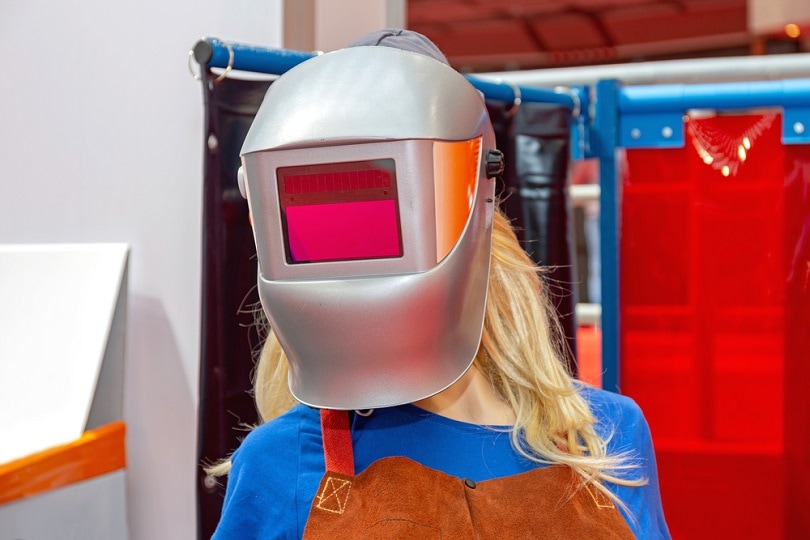
Shading Range
The shade number is the amount or intensity of light that passes through the lens and into your eye. The higher the shade number, the more light is prevented from getting through. The higher the shade number, the darker the filter.
Modern welding helmets tend to offer a range, rather than a fixed shading level. For welding, 8 or higher is recommended for TIG welding, while 10 to 13 or higher is ideal for MIG welding. Lower numbers, from around 5 to 8, are used for plasma cutting and grinding. The lower numbers still allow enough light through so that you can make accurate cuts but protect against the bright light.
Viewing Area
Welding helmets use electronic sensors, displays, and viewers. The size of the viewer determines how wide and tall a field of view you have. Some projects may require that you only need a small field of view, while others require a much larger viewing area. Most manufacturers publish the viewing area of their helmets so that you can ensure a good field of view for your work. If the field of view is too small for your application, you will have to move your workpiece or head around more.

Weight
The weight of the welding mask influences several factors. Lightweight masks are more comfortable and easier to flip and use. But they can feel flimsy and may be more easily damaged than heavier ones. Determining the best weight will depend on personal preference and whether you are comfortable wearing a heavy mask.
Comfort and Adjustability
Masks fit around and over the head to keep them in place and ensure a snug fit that protects more of your head and face from potential injury. But we all have different shapes and sizes of faces and heads, so a mask should have adjustable headgear. It should be easy to adjust but remain in place once you’ve set it to the right shape.
Power Source
The sensors, viewers, and digital controls of a welding helmet require a power source. In most cases, this means small batteries. The batteries may be replaceable, and a decent battery can last a year or two before it needs replacing. Some are solar-charged, so they will recharge in sunlight, which is helpful if you weld in a sunny, outdoor environment. A few helmets also offer USB or other charging methods, so you can always ensure you have a full charge, and the auto-darkening feature can do its job effectively.
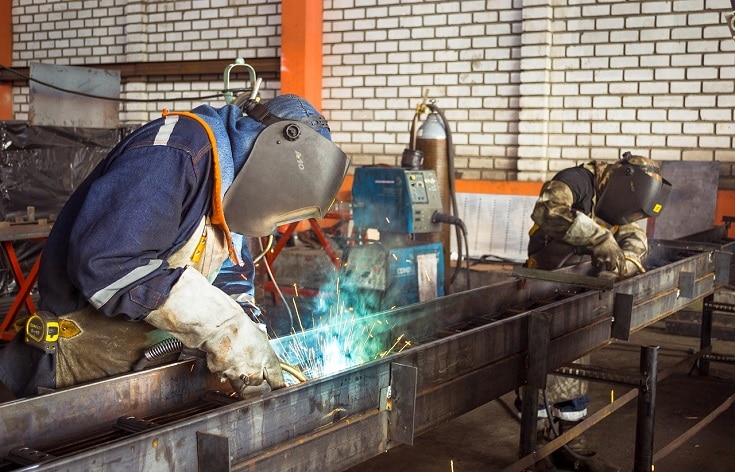
What Is Arc-Eye?
Arc eye is caused when the eye is exposed to too much ultraviolet light. Its proper name is photokeratitis, which can lead to blurred vision and swollen eyes. It is usually a temporary condition, and the eye will recover after a short period, but continued exposure to UV light can lead to more permanent damage, hence the importance of a good welding helmet.
What Is Welder’s Flash?
Welder’s flash is another name given to arc-eye because it is commonly caused by exposure to the UV generated by welding torches.
How Long Does It Take for Welder’s Eye to Heal?
If you suffer from welder’s eye, you can use eye drops to help alleviate the symptoms, and the problem will usually go away naturally, on its own. This can take a day or two before arc-eye is completely healed.
Conclusion
Welding is a potentially dangerous activity. You must use the appropriate safety equipment while following best practices to minimize the risk of injury and damage, especially to the eyes, face, and head. A welding mask is the primary source of protection, and there are masks suitable for hobbyists or occasional welders, as well as professionals that spend hours each day welding.
While compiling the reviews above, we found the ESAB Sentinel 150 to be the best overall welding helmet because of its reasonable price and professional-level protection and features. For a budget-friendly option, the Antra AH6-260-0000 is a good choice for the hobbyist welder that wants decent protection at an affordable price.



